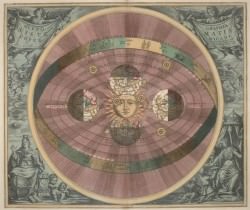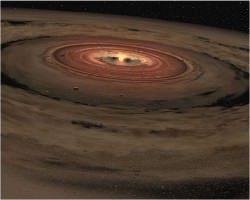[/caption]
In ancient times, astronomers thought that all celestial objects – the Sun, Moon, planets and stars – orbited around the Earth in a series of crystal spheres. But as modern science developed, astronomers were better able to understand our place in the cosmos. They discovered that all the planets, including the Earth, actually orbit around the Sun.
Not only did scientists discover that the simple fact that the planets orbit the Sun, they uncovered the underlying reasons for why. What chain of events led us to our current Solar System, with planets orbiting the Sun?
Astronomers Used to Think the Earth was the Center of the Solar System
 Because we live on Earth, and we see objects passing across our view of the skies, it’s natural to assume that the Earth is the center of the Universe. In fact, this perspective – known as geocentrism – was the default for all ancient civilizations. The Sun, the Moon, the planets and the stars appeared to move around the Earth each day. And because the Earth itself didn’t seem to be moving, astronomers like Ptolemy assumed that Earth was the center of the Universe. In fact, they went so far as to create very detailed models for predicting the motions of objects with a high degree of accuracy, using this completely inaccurate model of the Solar System. The predictions made by Ptolemy were used to make astrological predictions for more than 1500 years, until a much better model came along.
Because we live on Earth, and we see objects passing across our view of the skies, it’s natural to assume that the Earth is the center of the Universe. In fact, this perspective – known as geocentrism – was the default for all ancient civilizations. The Sun, the Moon, the planets and the stars appeared to move around the Earth each day. And because the Earth itself didn’t seem to be moving, astronomers like Ptolemy assumed that Earth was the center of the Universe. In fact, they went so far as to create very detailed models for predicting the motions of objects with a high degree of accuracy, using this completely inaccurate model of the Solar System. The predictions made by Ptolemy were used to make astrological predictions for more than 1500 years, until a much better model came along.
Actually, the Sun is the Center of the Solar System
 A new, more accurate model of the Solar System didn’t come around until the 16th century, when the Polish astronomer Nicolai Copernicus published his Universe-changing book: On the Revolutions of the Heavenly Bodies. Copernicus accurately reorganized the Solar System, putting the Sun at the center in a heliocentric model. And the Earth took its proper place, as just another planet orbiting the Sun – one of the 6 known to astronomers at the time.
A new, more accurate model of the Solar System didn’t come around until the 16th century, when the Polish astronomer Nicolai Copernicus published his Universe-changing book: On the Revolutions of the Heavenly Bodies. Copernicus accurately reorganized the Solar System, putting the Sun at the center in a heliocentric model. And the Earth took its proper place, as just another planet orbiting the Sun – one of the 6 known to astronomers at the time.
Copernicus’ model helped answer two questions which had troubled astronomers for centuries: why the planets brighten and dim over the course of several months (because they’re getting closer and further away), and why the planets seem to reverse and move in a retrograde direction. Easily explained because of the changing positions of the Earth, planets and the background stars.
But Why Do They Orbit the Sun?
 Once they could accurately describe the nature of the planetary motion in the Solar System, they were left with a more fundimental question: Why do the planets orbit the Sun? What sequence of events led to the current motions of the planets around the Sun?
Once they could accurately describe the nature of the planetary motion in the Solar System, they were left with a more fundimental question: Why do the planets orbit the Sun? What sequence of events led to the current motions of the planets around the Sun?
To explain this, we need to look back 4.6 billion years ago, before there was even a Solar System. In our place instead, there was a massive cloud of hydrogen gas left over from the Big Bang. Some event, like a nearby supernova explosion triggered a gravitational collapse of the cloud, causing the hydrogen atoms to attach to one another through mutual gravity.
Each individual hydrogen atom had its own momentum, and so when the atoms collected together into larger and larger clumps of gas, the conservation of momentum across all the particles set these clumps of gas spinning. Imagine two spinning skydivers colliding with one another in mid-air; after their collision, they’ll have a new rotation speed and direction based on the addition of their original directions.
Eventually all of this hydrogen gas was collected together into a massive spinning ball of gas that continued to collapse under its own gravity. As it collapsed, it began to spin faster and faster, just like a figure skater pulling in her arms increases her rotation speed.
The spinning cloud of gas and dust flattened out because of the rotational force, with the Sun at the center, and then a pancake-shaped disc of material surrounding it. The planets formed out of this disk of material, collecting together particles of dust into larger and larger rocks until planet-sized objects had accumulated together.
The Planets are in Perfect Balance
The planets orbit the Sun because they’re left over from the formation of the Solar System. Their current motion depends on the gravitational attraction of the Sun at the center of the Solar System. In fact, they’re in perfect balance.
There are two opposing forces acting on the planets: gravity pulling them inward, and the inertia of their orbit driving them outwards. If gravity was dominant, the planets would spiral inward. If their inertia was dominant, the planets would spiral outward into deep space.
The planets are trying to fly out into deep space, but the gravity of the Sun is pulling them into a curved orbit.
Research further:
Cornell Astronomy
The Universe of Aristotle and Ptolemy
Copernical Model: A Sun-Centered Solar System
The Solar Nebula
On the Revolution of the Heavenly Bodies
The Copernican Revolution

